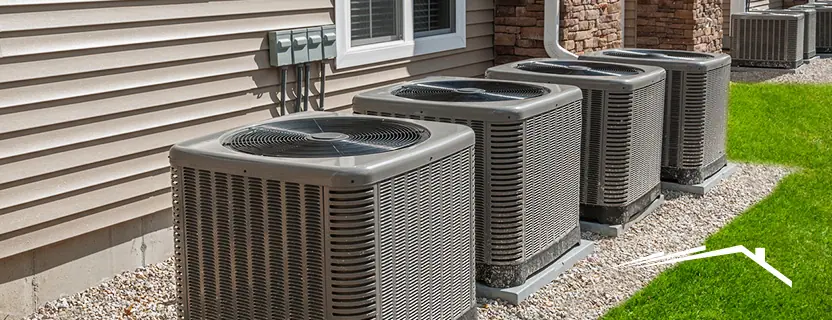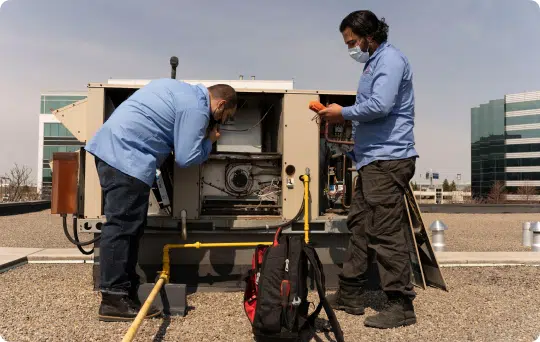Breaking Down the ROI on furnace replacement
Breaking Down the ROI on furnace replacement
Blog Article
Just How a Warmth Pump and Heating System Interact to Maximize Your Home's Heating Efficiency
Understanding exactly how a warm pump and furnace job together is vital for property owners looking for effective heating remedies. Each system has its staminas, giving a balanced approach to home convenience. The heatpump stands out in modest temperatures, while the furnace provides rapid heat during extreme cold. This synergy not just reduces power expenses but also boosts the life expectancy of both devices. What elements affect this collaboration, and just how can house owners maximize their benefits?
Recognizing Heat Pumps: Just How They Work
Numerous individuals might be unfamiliar with their internal operations, warmth pumps play a vital duty in modern heating systems. These gadgets run by moving heat from one area to another, using the concepts of thermodynamics. In cooler months, a warmth pump removes heat from the outside air, ground, or water, and transfers it inside your home to heat the space. Conversely, during warmer months, it can reverse the process, working as an air conditioning unit by getting rid of warmth from inside to the outside.Heat pumps include an evaporator, growth, condenser, and compressor shutoff. The cooling agent within the system absorbs warm as it vaporizes at reduced temperature levels and stress. The compressor after that boosts the pressure and temperature of the refrigerant, enabling it to release heat as it condenses. This efficient process can significantly minimize energy usage compared to traditional home heating approaches, making heatpump a lasting option for climate control in homes.
The Role of Heaters in Home Home Heating
Heating systems play a necessary function in home heating by offering a reputable source of heat throughout the chillier months. They run by creating warm through burning or electric resistance, distributing it throughout the home using air ducts or radiant systems. The performance of a heating system is typically measured by its Yearly Fuel Utilization Performance (AFUE) ranking, which suggests how effectively the unit transforms fuel into heat.Furnaces can use different energy resources, consisting of gas, electrical power, oil, or lp, allowing home owners to choose one of the most suitable choice for their needs. Unlike warmth pumps, which may have a hard time in severe chilly, heaters maintain constant efficiency, guaranteeing that interior temperatures stay comfy no matter outside problems. Additionally, contemporary furnaces usually come geared up with innovative technology, such as smart thermostats and variable-speed blowers, improving their efficiency and responsiveness. This convenience makes heating systems a crucial element in all-inclusive home heating approaches.

Advantages of Utilizing Both Equipments Together
Combining the strengths of both heaters and heatpump can result in a more effective and reliable home heating option. Using both systems enables property owners to capitalize on the heatpump's power effectiveness during milder temperature levels while depending on the furnace for even more severe cold problems. This double approach can greatly minimize energy costs, as warmth pumps take in much less electrical energy than conventional home heating techniques when temperature levels are moderate.Additionally, utilizing both systems with each other can improve convenience levels in the home. Heatpump can offer regular, even home heating, while furnaces can swiftly raise ambient temperatures when required. Additionally, the assimilation of both systems can extend the life-span of equipment by lowering wear and tear on each system, as they share the work. Ultimately, house owners can appreciate a balanced, cost-efficient heating service that changes flawlessly to varying climate condition, guaranteeing a cozy and inviting home throughout the winter season months.
Just How Heat Pumps and Furnaces Complement Each Various Other
When property owners integrate heatpump and heaters, they develop a corresponding home heating system that takes full advantage of performance and comfort. Heatpump run by moving warm from the outdoors air or ground, making them extremely effective in moderate climates. They succeed throughout milder temperature levels, supplying economical heating. On the other hand, heating systems produce heat through burning or electrical resistance, supplying strong, instant warmth throughout severe chilly conditions.The combination of these two systems permits vibrant changes based on temperature fluctuations. Throughout warmer months or milder winter season days, the warmth pump can take the lead, preserving power and minimizing expenses. As temperatures drop, the furnace can seamlessly involve, making certain regular heat throughout the home. This synergy not only maximizes energy use yet likewise enhances the life-span of both systems, as each device operates within its optimal performance range. With each other, they develop a balanced environment that adjusts to varying environment demands.
Maximizing Effectiveness: Tips for Homeowners
Property owners can boost their heating efficiency with several sensible techniques. Developing a routine upkeep routine, incorporating wise thermostat technology, and carrying out effective insulation and securing solutions are crucial steps. These procedures not just enhance convenience but likewise reduce energy prices.
Routine Upkeep Schedule
To ensure optimal heating effectiveness, developing a regular maintenance timetable is crucial for any type of home. Homeowners must prioritize regular inspections of both heatpump and furnaces to establish peak efficiency. This includes altering air filters each to 3 months, as clogged filters can considerably lower efficiency. Furthermore, scheduling professional upkeep a minimum of when a year allows service technicians to recognize and address prospective problems prior to they rise. Homeowners ought to likewise cleanse the heatpump's exterior unit to avoid debris accumulation that can impede air flow. By sticking to a routine upkeep routine, house owners not just boost their home heating systems' performance yet additionally expand their life-span, bring about better convenience and minimized power expenses throughout the chillier months.
Smart Thermostat Combination
Incorporating a wise thermostat into a home heating system can greatly boost energy efficiency, especially as it enables specific control over temperature level settings. These tools can discover the property owner's schedule and choices, immediately changing the temperature to maximize comfort while minimizing power use. They can lower home heating during times when the home is empty, decreasing unnecessary usage. Many wise thermostats also supply real-time energy usage information, allowing homeowners to make educated choices about their home heating habits. In addition, remote access by means of smartphone apps permits users to change setups from anywhere, ensuring the home is warm upon return. On the whole, clever thermostat combination not just improves comfort however substantially adds to power financial savings and efficiency.
Insulation and Sealing Solutions
Smart thermostats play a crucial role in energy effectiveness, you could try here however their efficiency can be substantially improved by appropriate insulation and securing solutions. House owners need to focus on insulating walls, attics, and floors to decrease heat loss. Premium insulation products, such as spray foam site here or fiberglass, can substantially boost thermal resistance. Additionally, sealing spaces around air ducts, doors, and home windows protects against cool air seepage and warmth retreat. Weatherstripping and caulking work approaches for resolving these leakages - heat pump service. Regular inspections for air leaks, in addition to making use of blower door examinations, can assist determine problem areas. By buying insulation and securing, property owners can enhance the performance of their heating unit, inevitably causing minimized energy usage and lower utility costs
Usual Myths About Warmth Pumps and Furnaces
What false impressions border heatpump and heating systems? Numerous individuals erroneously think that heat pumps are ineffective in cooler climates. In reality, modern-day warmth pumps are developed to operate successfully even in low temperatures, providing trustworthy heating throughout wintertime. An additional usual myth is that heaters are constantly more effective than warmth pumps. This depends on the certain energy resources and effectiveness rankings of the units in concern. Some may likewise assume that utilizing both systems simultaneously is unnecessary, yet as a matter of fact, this mix can maximize heating performance, particularly during severe climate condition. In addition, people usually assume that warmth pumps call for constant upkeep, when truthfully, they have similar upkeep requires to traditional home heating systems. By disproving these myths, property owners can make even more informed decisions regarding their home heating alternatives, ultimately leading to enhanced convenience and energy effectiveness in their homes.
Upkeep Factors To Consider for Combined Systems

Regularly Asked Concerns
Can Warmth Pumps Work Efficiently in Incredibly Cold Climates?
Warm pumps can struggle in very cool environments as a result of lowered performance and warmth extraction constraints. Advancements in technology have led to designs created for better performance in such conditions, improving their viability in rough environments.
Just How Long Do Warm Pumps and Furnaces Commonly Last?
Warmth pumps usually last 15 to two decades, while heaters have a life-span of 15 to three decades. Normal maintenance can prolong their durability, making sure efficient procedure and reducing the demand for premature substitutes.

What Is the Average Cost of Putting Up Both Solutions?
The average price of installing both a heatpump and a furnace typically ranges between $5,000 to $10,000 - heat pump replacement ooltewah tn. Elements influencing this expense include system dimension, setup complexity, and local labor prices
Are There Tax Obligation Rewards for Utilizing Energy-Efficient Home Heating Systems?
Many property owners ask about tax obligation motivations for energy-efficient heating unit. Numerous federal and state programs commonly supply credit ratings or refunds, urging the fostering of lasting modern technologies to minimize power intake and promote ecological duty.
Just how Do I Pick the Right Dimension Warm Pump and Heating System?
Picking the appropriate size warmth pump and heating system involves calculating the home's square video footage, thinking about insulation high quality, and reviewing regional climate. Consulting an expert can assure optimal system performance and energy effectiveness based upon specific requirements. heat pump service. Recognizing exactly how more a warm pump and heating system work with each other is important for homeowners seeking effective heating services. In chillier months, a warm pump removes heat from the outdoors air, ground, or water, and transfers it indoors to heat the living area. When house owners incorporate warmth pumps and furnaces, they produce a complementary heating system that optimizes efficiency and comfort. Heat pumps run by transferring heat from the outdoors air or ground, making them very efficient in moderate environments. Warmth pumps can struggle in incredibly chilly climates due to lowered performance and warmth extraction constraints
Report this page